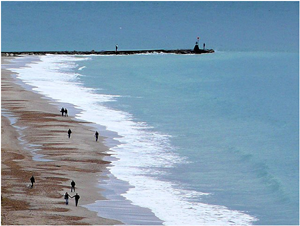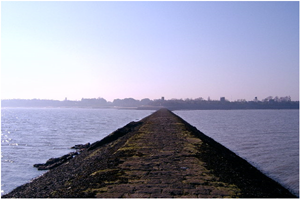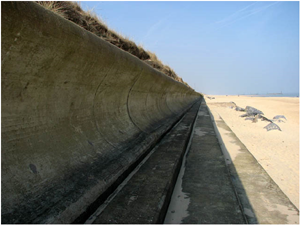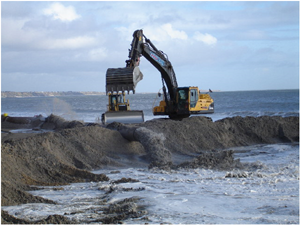Although nothing can be done to prevent storms, coastal engineers have made numerous attempts to control erosion through a wide range of methods. These can be classified as (1) energy dissipation through the use of hard structures or (2) supply supplemental sand to eroding beaches through dredging and beach nourishment projects. Both methods are expensive and controversial.

Nor’Ida, a powerful Nor’easter, plowed across the Outer Banks in mid November,
2009 leaving many of the beach dunes strewn across the road.
Through dredging of inlets and waterways, engineers are able to remove sediment where it is accreting, and deposit sediment where it is eroding. Beach armoring on the other hand works to maintain the integrity of the beach prior to erosion by dissipating energy heading towards the coast from storm-generated waves through the use of groins, breakwaters and sea walls.
Because of the dynamic nature of the coastline, most methods prove to be only temporarily effective. As the coastline becomes more populated and developed, the need for coastal mitigation will be in higher demand. Also, increasing property values along the coastline will certainly yield an increase in the costs of coastal mitigation, not just along the East Coast, but for taxpayers nationwide.
These increased costs raise the question of economic risks involved in coastal development, whether or not the economic benefits of coastal development exceed these risks, and who should pay for the costly endeavor of continuing coastal development. Our coastal areas are huge economic drivers for seaboard states. Beach tourism brings in many millions of dollars annually, as do commercial and recreational fishermen and other maritime industries. NOAA claims that coastal regions are the number one destination for tourists in America. Just as beautiful beaches foster healthy coastal economies, eroding or unusable beaches discourage tourists from visiting and spending.
Real-estate investment is also significant in coastal regions. United Nations consultant Don Hinrichsen estimates in a NOAA paper that 55-60% of Americans live in coastal regions (Atlantic, Pacific, Gulf Coast, and Great Lakes), and notes that these areas are becoming increasingly populated. According to Hinrichsen, 75% of Americans are projected to live in coastal counties by 2025. It is also estimated that the combined property value for the Outer Banks of North Carolina is near $27 billion. Clearly, such high coastal use and property values offer an enormous economic investment, though these regions are also in high-risk environments, prone to constant erosion and devastating storms.
One of the most controversial issues in coastal management is who ends up paying for the projects and who ends up benefiting. The costs of some projects can reach hundreds of millions of dollars and many feel that the wealthy, vacation-home owners unjustly benefit from the taxes of the general public. The Federal Government is the largest subsidizer for coastal projects. They pay roughly two-thirds to three-quarters of the cost, and local and state governments cover the rest. Beach nourishment is a continual cost that is often not factored in original estimates and can range from $350,000 to $3 million a mile. The US Army Corps of Engineers estimates that by 2010 the cost will exceed $58 million for coastal management projects each year in North Carolina. The debate will continue and new methods will develop to finance the never ending quest to maintain and preserve our nation's coasts.
For a complete and detailed risk assessment for coastal development including economic, environmental, societal, and hazard impacts please visit NOAA’s Risk and Vulnerability website at: http://www.csc.noaa.gov/rvat/data.html
Beach Projects
|
Groins 
This groyne marks the southernmost reach of Hengistbury Head and is the separating point between Poole Bay in the foreground and Christchurch Bay in the distance. This was taken from the top of Warren Hill.
|
|
|
|
Breakwaters 
Breakwater at the entrance to Harwich Harbour, looking toward Harwich Town |
|
|
|
Sea walls 
The concrete sea wall was built in this shape to deflect the power of the waves and to protect the dunes beyond. The large rocks seen beside it have been brought here from Norway. They were deposited alongside the seawall for protection from wave action but it did not take long for most of them to be almost totally buried in the sand and hence having lost most of their effectiveness. For comparison see this photo, which was taken 17 months earlier from the same location. Nearshore reefs can be seen in the background. Nine nearshore reefs were built for the protection of this section of coastline. Extending from North Gap to Sea Palling further in the southeast, four are surface-piercing breakwaters and the other five serve as submerged breakwaters at high tide. Sand builds up on the landward side of these reefs, creating a number of bays. See this site for more. Sea walls and revetments are designed specifically to protect coastal properties and other infrastructures on the coast. A temporary barrier made of concrete, steel, wood or rocks is implemented to withstand storm surge and to absorb and divert waves hitting the coast. Many sea walls are built knowing that one day the beach will be gone and the temporary sea wall will be the last resort to protect properties from storms and waves.
|
|
|
|
Dredging & Beach Nourishment 
The beach end of the £5million Poole Harbour deep water channel dredging and beach rebuilding project, a 24 hour/7day contract throughout December 2005 and January 2006. This major project has 2 main benefits in refurbishing the Blue Flag award winning beaches providing additional coastal protection and at the same time improving the deep water access for car ferries and commercial shipping into Poole. |
|
|
Coastal management encompasses an array of agencies and agendas. Though all contribute in their own way to coastal management efforts, it is the Office of Ocean and Coastal Resources Management (OCRM) section of the National Oceanic and Atmospheric Administration (NOAA) that is primarily responsible for implementing the federal Coastal Zone Management Act (CZMA), which was established with the intent of cohesively setting goals for the national management of beaches. Because management programs are distributed among many different agencies it is important to consider coastal zone management from both national and local perspectives.
State and local agencies are key players as they have an increased ability to create site specific regulations. The CZMA provides states with management power and, in turn, many states require local governments to draft and enact planning requirements that must meet certain standards. However, ecosystems and beaches don’t correlate with state or county lines and as a result regional and multistate administration programs also exist. Some of these agencies enforce the management and installation of jetties, dikes, groins, breakwaters, and seawalls. Others attempt to use creative thinking, engineering, and education to construct more sustainable, ecologically friendly designs and planning initiatives. With so many involved agencies at various levels, the intricacies of the coastal management network are complex, but through them arises the opportunity for innovative new ways to interact with and manage the coast.
